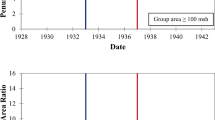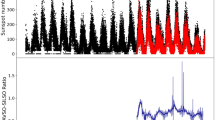Abstract
This article is an update of a study (Tapping and Valdès in Solar Phys. 272, 337, 2011) made in the early part of Cycle 24 using an intercomparison of various solar activity indices (including sunspot number and the 10.7 cm solar radio flux), in which it was concluded that a change in the relationship between photospheric and chromospheric/coronal activity took place just after the maximum of Cycle 23 and continued into Cycle 24. Precursors (short-term variations) were detected in Cycles 21 and 22. Since then the sunspot number index data have been substantially revised. This study is intended to be an update of the earlier study and to assess the impact of the revision of the sunspot number data upon those conclusions. This study compares original and revised sunspot number, total sunspot area, and 10.7 cm solar radio flux. The conclusion is that the transient changes in Cycles 21 and 22, and the more substantial change in Cycle 23, remain evident. Cycle 24 shows indications that the deviation was probably another short-term one.








Similar content being viewed by others
References
Athay, R.G., Warwick, C.S.: 1961, Indices of solar activity. Adv. Geophys. 8, 1. DOI . ADS .
Charbonneau, P., Blais-Laurier, G., St-Jean, C.: 2004, Intermittency and phase persistence in a Babcock–Leighton model of the solar cycle. Astrophys. J. Lett. 616, L183. DOI . ADS .
Charbonneau, P., St-Jean, C., Zacharias, P.: 2005, Fluctuations in Babcock–Leighton dynamos. I. Period doubling and transition to chaos. Astrophys. J. 619, 613. DOI . ADS .
Choudhuri, A.R.: 2003, In: Dwivedi, B.N., Parker, F.b.E.N. (eds.) The Solar Dynamo as a Model of the Solar Cycle, 103. ADS .
Clette, F., Lefèvre, L.: 2016, The new sunspot number: Assembling all corrections. Solar Phys. 291, 2629. DOI . ADS .
Clette, F., Lefèvre, L., Cagnotti, M., Cortesi, S., Bulling, A.: 2016, The revised Brussels–Locarno sunspot number (1981 – 2015). Solar Phys. 291, 2733. DOI . ADS .
Eddy, J.A.: 1976a, The Maunder minimum. Science 192, 1189. DOI . ADS .
Eddy, J.A.: 1976b, The sun since the Bronze Age. In: Williams, D.J. (ed.) Physics of Solar Planetary Environments, 958. ADS .
Eddy, J.A.: 1977, Historical evidence for the existence of the solar cycle. In: White, O.R. (ed.) The Solar Output and its Variation, 51. ADS .
Eddy, J.A.: 1979, Limits of historical evidence of solar variability. In: Robertson, P.C., Pepin, R.O., Eddy, J.A., Merrill, R.B. (eds.) The Ancient Sun: Fossil Record in the Earth, Moon and Meteorites, LPI Contributions 390, 22. ADS .
Janardhan, P., Bisoi, S.K., Gosain, S.: 2010, Solar polar fields during cycles 21 – 23: Correlation with meridional flows. Solar Phys. 267, 267. DOI . ADS .
Janardhan, P., Bisoi, S.K., Ananthakrishnan, S., Sridharan, R., Jose, L.: 2015, Solar and interplanetary signatures of a Maunder-like grand solar minimum around the corner – implications to near-Earth space. Sun Geosph. 10, 147. ADS .
Komitov, B., Kaftan, V.: 2004, The sunspot activity in the last two millenia on the basis of indirect and instrumental indexes: Time series models and their extrapolations for the 21st century. In: Stepanov, A.V., Benevolenskaya, E.E., Kosovichev, A.G. (eds.) Multi-Wavelength Investigations of Solar Activity, IAU Symposium 223, 113. DOI . ADS .
Krüger, A.: 1979, Introduction to Solar Radio Astronomy and Radio Physics. ADS .
Kundu, M.R.: 1965, Solar Radio Astronomy. ADS .
Livingston, W., Penn, M.J., Svalgaard, L.: 2012, Decreasing sunspot magnetic fields explain unique 10.7 cm radio flux. Astrophys. J. Lett. 757, L8. DOI . ADS .
Lockwood, M., Stamper, R.: 1999, Long-term drift of the coronal source magnetic flux and the total solar irradiance. Geophys. Res. Lett. 26, 2461. DOI . ADS .
Penn, M.J., Livingston, W.: 2006, Temporal changes in sunspot umbral magnetic fields and temperatures. Astrophys. J. Lett. 649, L45. DOI . ADS .
Penn, M.J., Livingston, W.: 2011, Long-term evolution of sunspot magnetic fields. In: Prasad Choudhary, D., Strassmeier, K.G. (eds.) Physics of Sun and Star Spots, IAU Symposium 273, 126. DOI . ADS .
Sarychev, A.P., Roshchina, E.M.: 2006, Total sunspot area as a solar activity index. Solar Syst. Res. 40, 521. DOI . ADS .
Tapping, K.F.: 2013, The 10.7 cm solar radio flux (F10.7). Space Weather 11, 394. DOI . ADS .
Tapping, K.F., Valdés, J.J.: 2011, Did the sun change its behaviour during the decline of cycle 23 and into cycle 24? Solar Phys. 272, 337. DOI . ADS .
Usoskin, I.G.: 2008, A history of solar activity over millennia. Living Rev. Solar Phys. 5, 3. DOI . ADS .
Acknowledgements
The authors owe a great vote of thanks to the Royal Observatory, Belgium, for the ongoing effort in providing the longest-duration, consistent direct record of solar activity available. Thanks are also due to the Royal Greenwich Observatory and now NASA for providing the also long-duration time-series of total sunspot area data. This research was supported by the National Research Council of Canada. One of the authors (CMM) was supported by the NRC Student Programme and by the University of Victoria, British Columbia.
Author information
Authors and Affiliations
Corresponding authors
Ethics declarations
Disclosure of Potential Conflicts of Interest
The authors declare there are no conflicts of interest with respect to the contents of this paper or the data used in it.
Rights and permissions
About this article
Cite this article
Tapping, K., Morgan, C. Changing Relationships Between Sunspot Number, Total Sunspot Area and \(F_{10.7}\) in Cycles 23 and 24. Sol Phys 292, 73 (2017). https://doi.org/10.1007/s11207-017-1111-6
Received:
Accepted:
Published:
DOI: https://doi.org/10.1007/s11207-017-1111-6




